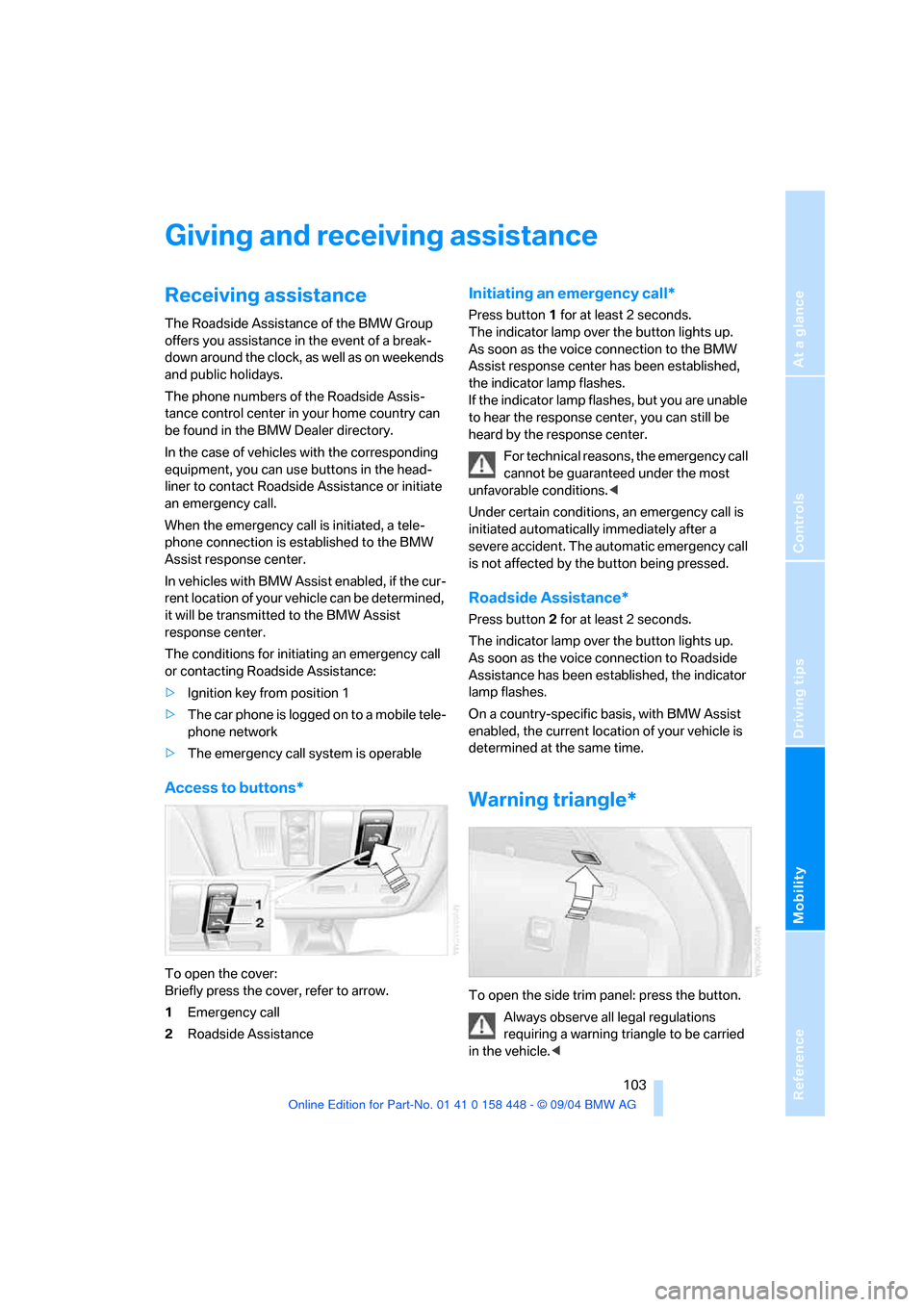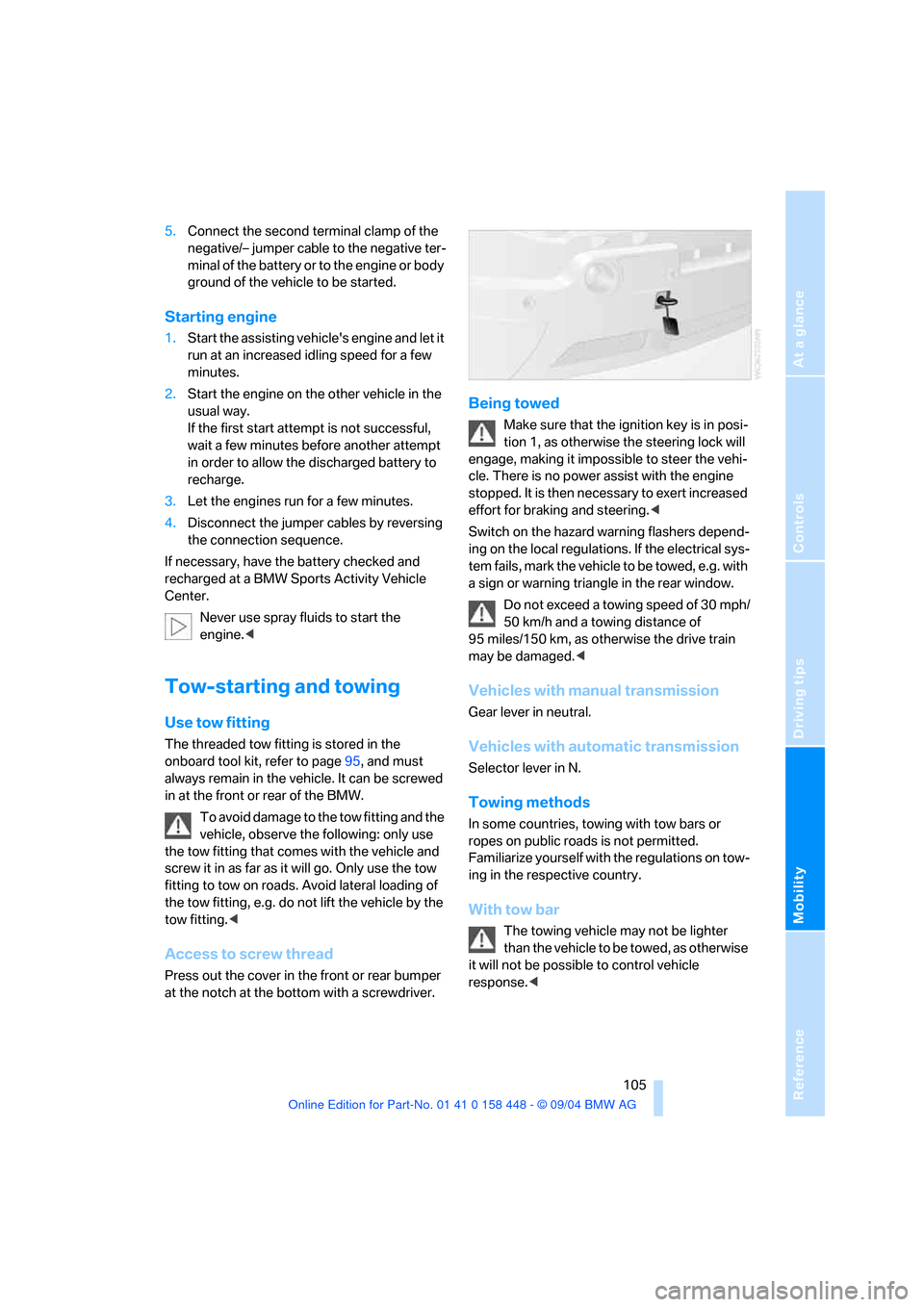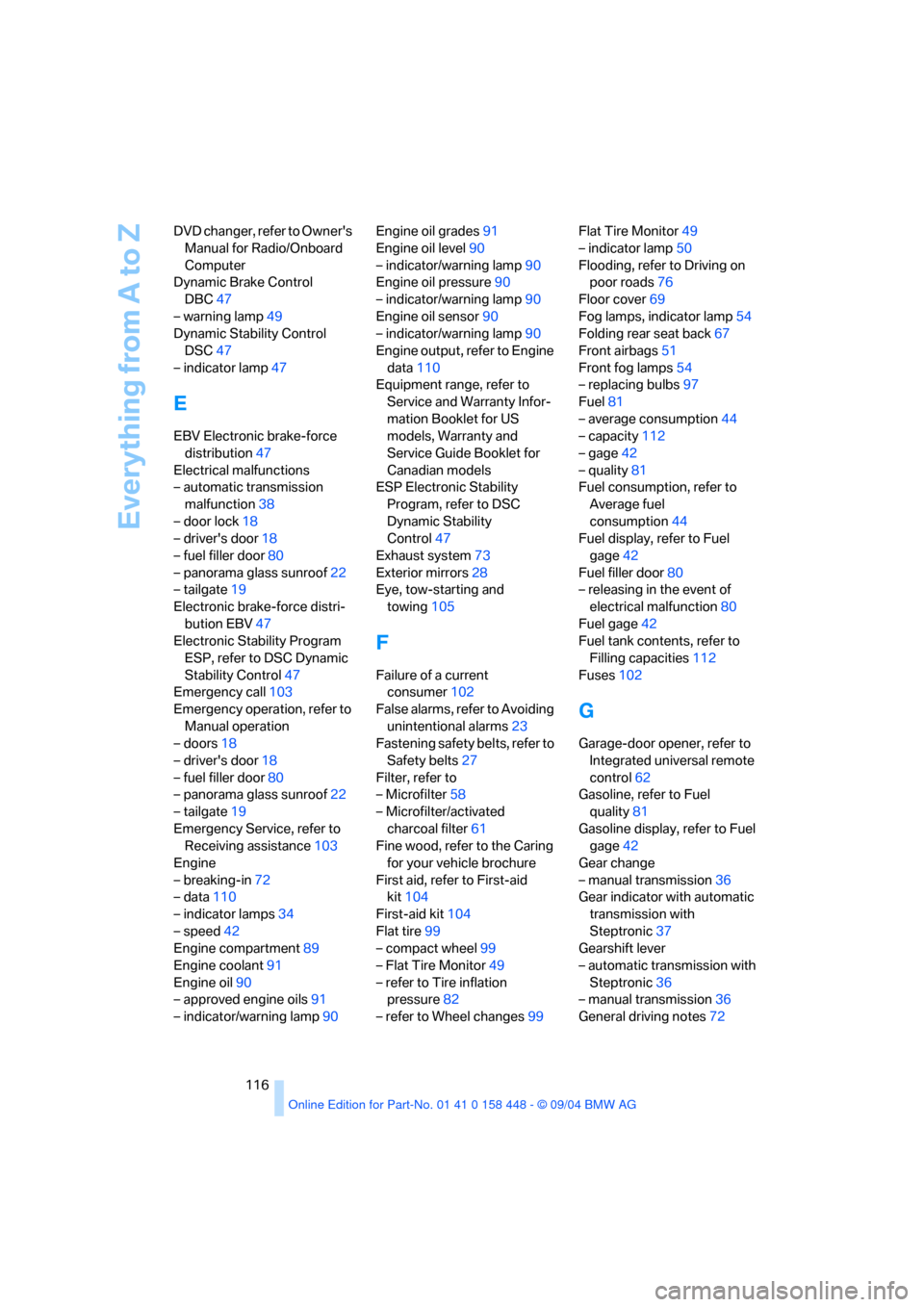ESP BMW X3 3.0I 2005 E83 Owner's Guide
[x] Cancel search | Manufacturer: BMW, Model Year: 2005, Model line: X3 3.0I, Model: BMW X3 3.0I 2005 E83Pages: 126, PDF Size: 4.65 MB
Page 95 of 126

Maintenance
94 the bottom of the instrument cluster and under
a cover. The cover has the letters OBD on it.
The most important components for the com-
position of the emissions can be checked by a
device via this interface.
If the Service Engine Soon indicator
lamp lights up either continuously or
intermittently, this indicates a malfunc-
tion in the emissions-related electronic sys-
tems. Although the vehicle remains operational,
you should have the systems checked by your
BMW Sports Activity Vehicle Center at the ear-
liest possible opportunity.
The illuminated indicator informs you of the
need for service, not that you need to stop the
vehicle. However, the systems should be
checked by your BMW Sports Activity Vehicle
Center at the next opportunity.
If the indicator blinks or flashes, this indicates
a high level of engine misfire. Reduce speed
and contact the nearest BMW Sports Activity
Vehicle Center immediately. Severe engine
misfiring over even a short period of time can
seriously damage emission control system
components, especially the catalytic converter.
Display of the previously described
malfunction on Canadian models.
If the fuel filler cap is not on tight enough,
the OBD system can detect leaking vapor
and the indicator lamp will light up. If the fuel
filler cap is then tightened, the indicator lamp
will usually go out after a short period of time.<
Event Data Recorders
Your vehicle may be equipped with one or more
sensing and diagnostic modules or a recording
device capable of recording or transmitting cer-
tain vehicle data or information. In addition, if
you have a Subscription Service Agreement for
the BMW Assist system, certain vehicle infor-
mation may be transmitted or recorded in order
to provide such services.
Care
For all information on this subject, refer to the
Caring for your vehicle brochure.
Page 104 of 126

Reference
At a glance
Controls
Driving tips
Mobility
103
Giving and receiving assistance
Receiving assistance
The Roadside Assistance of the BMW Group
offers you assistance in the event of a break-
down around the clock, as well as on weekends
and public holidays.
The phone numbers of the Roadside Assis-
tance control center in your home country can
be found in the BMW Dealer directory.
In the case of vehicles with the corresponding
equipment, you can use buttons in the head-
liner to contact Roadside Assistance or initiate
an emergency call.
When the emergency call is initiated, a tele-
phone connection is established to the BMW
Assist response center.
In vehicles with BMW Assist enabled, if the cur-
rent location of your vehicle can be determined,
it will be transmitted to the BMW Assist
response center.
The conditions for initiating an emergency call
or contacting Roadside Assistance:
>Ignition key from position 1
>The car phone is logged on to a mobile tele-
phone network
>The emergency call system is operable
Access to buttons*
To open the cover:
Briefly press the cover, refer to arrow.
1Emergency call
2Roadside Assistance
Initiating an emergency call*
Press button 1 for at least 2 seconds.
The indicator lamp over the button lights up.
As soon as the voice connection to the BMW
Assist response center has been established,
the indicator lamp flashes.
If the indicator lamp flashes, but you are unable
to hear the response center, you can still be
heard by the response center.
For technical reasons, the emergency call
cannot be guaranteed under the most
unfavorable conditions.<
Under certain conditions, an emergency call is
initiated automatically immediately after a
severe accident. The automatic emergency call
is not affected by the button being pressed.
Roadside Assistance*
Press button 2 for at least 2 seconds.
The indicator lamp over the button lights up.
As soon as the voice connection to Roadside
Assistance has been established, the indicator
lamp flashes.
On a country-specific basis, with BMW Assist
enabled, the current location of your vehicle is
determined at the same time.
Warning triangle*
To open the side trim panel: press the button.
Always observe all legal regulations
requiring a warning triangle to be carried
in the vehicle.<
Page 106 of 126

Reference
At a glance
Controls
Driving tips
Mobility
105
5.Connect the second terminal clamp of the
negative/– jumper cable to the negative ter-
minal of the battery or to the engine or body
ground of the vehicle to be started.
Starting engine
1.Start the assisting vehicle's engine and let it
run at an increased idling speed for a few
minutes.
2.Start the engine on the other vehicle in the
usual way.
If the first start attempt is not successful,
wait a few minutes before another attempt
in order to allow the discharged battery to
recharge.
3.Let the engines run for a few minutes.
4.Disconnect the jumper cables by reversing
the connection sequence.
If necessary, have the battery checked and
recharged at a BMW Sports Activity Vehicle
Center.
Never use spray fluids to start the
engine.<
Tow-starting and towing
Use tow fitting
The threaded tow fitting is stored in the
onboard tool kit, refer to page95, and must
always remain in the vehicle. It can be screwed
in at the front or rear of the BMW.
To avoid damage to the tow fitting and the
vehicle, observe the following: only use
the tow fitting that comes with the vehicle and
screw it in as far as it will go. Only use the tow
fitting to tow on roads. Avoid lateral loading of
the tow fitting, e.g. do not lift the vehicle by the
tow fitting.<
Access to screw thread
Press out the cover in the front or rear bumper
at the notch at the bottom with a screwdriver.
Being towed
Make sure that the ignition key is in posi-
tion 1, as otherwise the steering lock will
engage, making it impossible to steer the vehi-
cle. There is no power assist with the engine
stopped. It is then necessary to exert increased
effort for braking and steering.<
Switch on the hazard warning flashers depend-
ing on the local regulations. If the electrical sys-
tem fails, mark the vehicle to be towed, e.g. with
a sign or warning triangle in the rear window.
Do not exceed a towing speed of 30 mph/
50 km/h and a towing distance of
95 miles/150 km, as otherwise the drive train
may be damaged.<
Vehicles with manual transmission
Gear lever in neutral.
Vehicles with automatic transmission
Selector lever in N.
Towing methods
In some countries, towing with tow bars or
ropes on public roads is not permitted.
Familiarize yourself with the regulations on tow-
ing in the respective country.
With tow bar
The towing vehicle may not be lighter
than the vehicle to be towed, as otherwise
it will not be possible to control vehicle
response.<
Page 117 of 126

Everything from A to Z
116 DVD changer, refer to Owner's
Manual for Radio/Onboard
Computer
Dynamic Brake Control
DBC47
– warning lamp49
Dynamic Stability Control
DSC47
– indicator lamp47
E
EBV Electronic brake-force
distribution47
Electrical malfunctions
– automatic transmission
malfunction38
– door lock18
– driver's door18
– fuel filler door80
– panorama glass sunroof22
– tailgate19
Electronic brake-force distri-
bution EBV47
Electronic Stability Program
ESP, refer to DSC Dynamic
Stability Control47
Emergency call103
Emergency operation, refer to
Manual operation
– doors18
– driver's door18
– fuel filler door80
– panorama glass sunroof22
– tailgate19
Emergency Service, refer to
Receiving assistance103
Engine
– breaking-in72
– data110
– indicator lamps34
– speed42
Engine compartment89
Engine coolant91
Engine oil90
– approved engine oils91
– indicator/warning lamp90Engine oil grades91
Engine oil level90
– indicator/warning lamp90
Engine oil pressure90
– indicator/warning lamp90
Engine oil sensor90
– indicator/warning lamp90
Engine output, refer to Engine
data110
Equipment range, refer to
Service and Warranty Infor-
mation Booklet for US
models, Warranty and
Service Guide Booklet for
Canadian models
ESP Electronic Stability
Program, refer to DSC
Dynamic Stability
Control47
Exhaust system73
Exterior mirrors28
Eye, tow-starting and
towing105
F
Failure of a current
consumer102
False alarms, refer to Avoiding
unintentional alarms23
Fastening safety belts, refer to
Safety belts27
Filter, refer to
– Microfilter58
– Microfilter/activated
charcoal filter61
Fine wood, refer to the Caring
for your vehicle brochure
First aid, refer to First-aid
kit104
First-aid kit104
Flat tire99
– compact wheel99
– Flat Tire Monitor49
– refer to Tire inflation
pressure82
– refer to Wheel changes99Flat Tire Monitor49
– indicator lamp50
Flooding, refer to Driving on
poor roads76
Floor cover69
Fog lamps, indicator lamp54
Folding rear seat back67
Front airbags51
Front fog lamps54
– replacing bulbs97
Fuel81
– average consumption44
– capacity112
– gage42
– quality81
Fuel consumption, refer to
Average fuel
consumption44
Fuel display, refer to Fuel
gage42
Fuel filler door80
– releasing in the event of
electrical malfunction80
Fuel gage42
Fuel tank contents, refer to
Filling capacities112
Fuses102
G
Garage-door opener, refer to
Integrated universal remote
control62
Gasoline, refer to Fuel
quality81
Gasoline display, refer to Fuel
gage42
Gear change
– manual transmission36
Gear indicator with automatic
transmission with
Steptronic37
Gearshift lever
– automatic transmission with
Steptronic36
– manual transmission36
General driving notes72